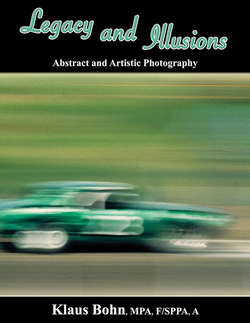Читать книгу Legacy and Illusions: Abstract and Artistic Photography - Klaus Bohn - Страница 8
ОглавлениеPreface
Artistic Perception and Interpretation
Concealed Illusions – The Photographer’s Unknown Resource
Ninety-five percent of everything we do is unconscious. Consider this for a moment. We eat, dress, drive, and perform hundreds of other daily activities without much conscious thought at all. It’s like we’re on autopilot. Our actions and reactions, likes and dislikes, and most of our decision-making operate at this unconscious level.
Most lifelong patterns are imprinted on our subconscious minds at a very young age, usually before seven. These patterns influence our thoughts and emotions. They colour how we perceive the world and our place in it. In essence, we have unconscious filters through which all incoming sensual data are processed.
How does all of this apply to you as a photographer?
Although your conscious mind plays an important role in how and what you photograph or edit, your subconscious patterns play a far greater role than you might realize. When you concentrate on a subject, you may or may not notice the smells and sounds around you. And you are certainly not aware of what your peripheral vision is picking up. In fact, your subconscious mind is pulling in millions of bits of information every second. Most is discarded, but much of it is processed through those filters mentioned above.
These unobserved inputs are constantly swaying your choices of f-stop, composition, angle, focus, cropping, and hundreds of other essentials. As a professional, you make many of these decisions instantly.
Cognitive & Perceptive Cycles
There is a biorhythm that operates 24/7 in our body known as the Basic Rest-Activity Cycle (BRAC). While some biological cycles last for many days, the BRAC oscillates consistently at between 90 and 120 minutes. During the Active phase of the cycle, we tend to be more logical, more detail-oriented, and take a black and white (all or nothing) approach to everything. Conversely, the Rest segment is typified by being holistic, creative, and we like to consider the big picture.
So, how does this influence taking or editing that photo? Just being aware of this psychological cycle, you will be better equipped to know what biases are influencing your decisions. Whether setting up a shot or editing, you may be either logical and rational on one extreme, or highly creative and imaginative on the other. Of course, you may also be between cycles. Do what you have to do, and then give it a review in another thirty minutes. You will be critiquing the job with a new mind!
Are you Visual, Auditory, or Kinesthetic?
Although each of us is a blend of these three profiles, some people live, learn, and communicate in a dominant one. Since you’re a photographer, you must have some visual tendencies. If you also happen to be somewhat kinesthetic, a hands-on approach will be evident in how you view and ultimately present your subject matter. A kinesthetic inclination might also include emotional considerations. Being aware of your unique style will enhance your decision making, whether conscious or unconscious.
Brian Walsh, PhD
Brian Walsh, PhD is the author of numerous books on self-empowerment, interpersonal communications, and enriched learning. He is a Master Practitioner of Neurolinguistic Programming, a Clinical Hypnotherapist, an Emotional Freedom Technique Practitioner, and an Acupuncture Detoxification Specialist.
